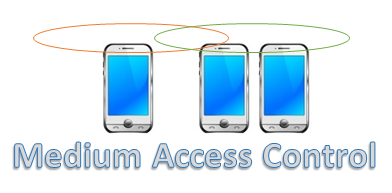Medium Access Control
Medium access control (MAC) is a collection of mechanisms that regulates user access to a medium using SDM, TDM, FDM, or CDM. MAC belongs to the data link control layer of the OSI model.

The data link layer is made up of two sub layers viz:
1. Logical link control (LLC)
2. MAC
The purpose of data link layer is to establish a reliable point to point or point to multi point connections between different devices over a wired or wireless medium.
Motivation for a Specialized Mac
The most popular MAC scheme for wired networks in CSMA/CD
(Carrier Sense Multiple Access and Collision Detection). In case of CSMA/CD.
1. A Sender listens to the medium to see if it is free.
2. If the medium is found busy, the Sender waits until it is free.
3. If the medium is found free, the Sender starts transmitting data and continues to listen to the medium.
4. Immediately when the Sender detects collision, it stops at once.
Unfortunately, this scheme fails for a wireless network because it is interested only in the collisions that can occur in the receivers and not in the sender.
The signal in case of wireless networks decrease in their strength as it travels larger distances.
A sender may now apply Carrier Sense and detect the medium as idle and may start transmitting over the medium that result in a collision. This problem is called the Hidden terminal problem.
The same can happen even during collision detection i.e. a sender detects no collision and assumes that the data has been transmitted without errors,
Where as a collision would have actually damaged the data at the receiver. Therefore we cannot use CSMA/CD of MAC for wireless networks.
Average Acceleration Calculator
Average acceleration is the object's change in speed for a specific given time period. ...
When an object falls into the ground due to planet's own gravitational force is known a...
In Mathematics, the permutation can be explained as the arrangement of objects in a particular order. It is an ordered...
A rectangle can be explained as a 4-sided quadrilateral which contains equal opposite sides. In a rectangle
A three sided polygon which has three vertices and three angles is called a triangle. Equilateral triangle...






